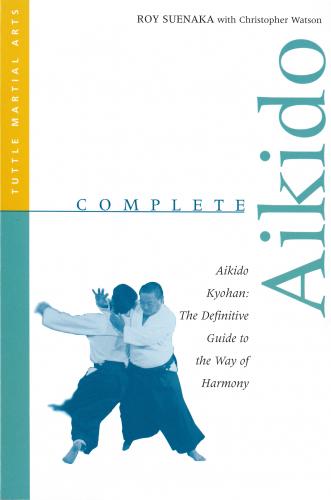By this time, Kise was familiar with Suenaka’s aikido, as Suenaka was familiar with Kise’s karate, both men having observed the other’s classes and technique with an educated, critical eye. Though neither man’s machismo would allow them to openly admit it, both were impressed with the other’s prowess and technique. Of the aikido Suenaka taught at the time, he notes: “It wasn’t like the aikido we have today; fairly similar, but probably a lot harder, a little more violent, so it impressed him.”
As the months passed, Suenaka’s student body outgrew the space available in Zemke Gym, forcing him to begin another class at Kadena’s second gym, McConnell Gym. At the same time Suenaka began entertaining thoughts of opening a dojo off-base, in town. For this, he would need O’Sensei’s blessing, which he secured upon his first return trip to the Hombu, less than a month after his move to Okinawa (“I didn’t waste any time. . . . I think then maybe I had more guts than brains.”). Again, the Founder was eager to introduce aikido to Okinawa, more so after the previous failed ventures. Ironically, it was a karateka, Shorinji-ryu karate founder Zenryo Shimabukuro, who guided Suenaka in this pursuit.
21-year-old Suenaka Sensei demonstrating ikkyo on student Allen Wagstajfin Zemke Gym, Kadena Air Force Base, Okinawa; Fall, 1961.
Suenaka first encountered Shimabukuro Sensei through Kiyotaka Nema, owner of the local sporting goods store where Suenaka purchased his gis and other supplies. (Although Fuse Kise was a student of Shimabukuro’s, as noted earlier, Suenaka hadn’t met him.) Suenaka mentioned to Nema his desire to open a dojo in town. “Nema said, ‘Oh, you don’t want to do that.’ He warned me. He said, ‘I don’t think aikido is going to go over very big in town. You want to stay on the base.’ But I told him I did, and he said, ‘I know a person who can help you.’” Nema took Suenaka to Shimabukuro’s dojo, about five miles outside of the air base. After observing a class, Nema introduced the two and told Shimabukuro of Suenaka’s plans. It’s remarkable that Shimabukuro, one of a scant handful otjudan (tenth degree black belt) in the area, in addition to being one of Okinawa’s most highly regarded karateka, was so willing to help. “He was a great master. For someone of his stature to say, ‘Okay, young man, I’ll help you,’ was really something,” Suenaka says. “He could have just as easily said ‘Look kid, why don’t you come and learn under me?’ But he respected me for wanting to teach aikido, and we became good friends. I had a lot more respect for him than he did for me, I’m sure, because of what he did for me.”
Shimabukuro Sensei called on a friend who was vice-president of a local bank and learned of a building in nearby Nakanomachi that would suit Suenaka’s needs, and his modest income. The low concrete structure housed a laundry in the left half, with the right half empty. There was a sliding, wooden warehouse-style door, four windows, no bathroom (“We went outside in the back of the building. All the plants there grew nice and green!”) and fifteen-hundred square feet of space; not a palace, but it would do, especially since rent was just fifteen dollars a month. Suenaka signed the lease.
Now that he had a building, Suenaka needed mats to make it a dojo. Again, Shimabukuro was there to help, putting Suenaka in touch with a local tatami (rice straw mat) maker who was a good friend of his, and from whom Shimabukuro purchased his mats. The tatami maker was more than willing to provide Suenaka with the mats:
“He said, ‘They’re special made . . . how many do you need?’ He was selling the mats for about five dollars each, which was ah incredibly low price even then, but he said he’d give them to me for about two-fifty apiece! Today, a standard residential tatami is about two-hundred fifty dollars, each. The tatami maker was selling residential tatami for two-and-a-half dollars, and the thick judo mats for five, so he was giving them to me for half price, and it took him the better part of a day to make just one, because he made them all by hand. But I didn’t know any of this. I said, ‘Boy, I’m gonna need about forty mats . . . that’s a hundred dollars!’ All he said was, ‘Please, come in, watch.’ And I watched him make a mat from scratch. I watched him gather the straw and bundle it, twist it, compressing it down, all by hand. After about two hours of watching him, he hadn’t even begun forming the mat yet. And that’s when I bowed and said, ‘I’m very sorry. Please forgive me. I should pay you more!’ But he said, ‘No, I’ll give you a discount, that’s okay. You’re a friend of a friend.’ I felt so humble, so small. They were exceptional mats, and I learned another lesson.”
Although Suenaka was grateful for Shimabukuro’s help, he had little time to further their relationship. He did attend several classes at Shimabukuro Sensei’s dojo, both out of curiosity and respect, and Shimabukuro observed one of Suenaka’s aikido classes. “He liked aikido. He said, ‘Aikido has nice, flowing moves.’ I think he was being straight with me. He was a very respected man in the area, so he had no need to lie.”
Конец ознакомительного фрагмента.
Текст предоставлен ООО «ЛитРес».
Прочитайте эту книгу целиком, купив полную легальную версию на ЛитРес.
Безопасно оплатить книгу можно банковской картой Visa, MasterCard, Maestro, со счета мобильного телефона, с платежного терминала, в салоне МТС или Связной, через PayPal, WebMoney, Яндекс.Деньги, QIWI Кошелек, бонусными картами или другим удобным Вам способом.
